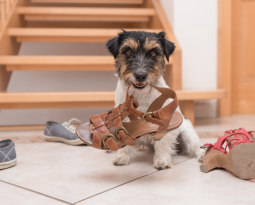Have you recently adopted a new pet? Brought home and started taking care of a stray or rescue? It’s a wonderful feeling but it can be undercut when you first realize that the pet is afraid of you or someone in your home. We’re here to help you! you think, but for the dog they’re not too sure yet of what to expect – and with reason. This time on the Acoma Animal Clinic blog we’re going to give you some tips and thoughts about how to help your new scared dog acclimate to you and their new home.
How to Help Your Scared Dog
When we see fear in children or other people our natural first response is to comfort them, to make them feel secure through our words and presence. When it comes to our dogs though this is actually the worst thing we can do in the situation. Here’s why:
Dog’s relate our behavior to whatever they are doing at that moment. This is what positive reinforcement training is built off of. You associate certain behaviors, tricks, etc. with rewards and positive reinforcement until. Then they understand “If I do this, I will get a treat or affection.”
You can probably puzzle out why our natural response is then going to be the worst option. If we comfort and show affection to a dog when they are scared or acting out – they begin to associate that behavior with getting a reward. This can cause a downward spiral in behavior to a timid, skittish pet that doesn’t get any better because they want to be rewarded!
Here’s one of the best ways to help your new dog start to feel safe and confident.
Allelomimetic Behavior
Allelomimetic behavior means that dogs learn by imitating. Traditionally this is learning through imitating other members of their species. A puppy learns how to be a dog through mimicking it’s older dog friends. Humans and dogs have a special relationship however that allows dogs to learn through mimicking us!
This behavior is why it is so crucial that we remain calm, assertive, and casual when the dog is afraid to help them overcome their fear. When they begin to understand that you are not afraid or nervous, they’ll start to understand that things are okay.
Here are some other things you can do to help welcome your new dog home.
Introduce the New Home Slowly
When you first bring the dog home, introduce them to the new area slowly. First introduce them to a single area, to help prevent them from feeling overwhelmed. This allows them to acclimate to the news sights, sounds, and smells of the home. Do your best to keep this environment as calm as possible. Speak softly to keep things from being too loud. The less stimulation the better to keep the environment as non-threatening as possible.
Over time they’ll begin to acclimate and feel safer at this home, which can help them with their fear of you.
Provide Access to Food Consistently
For many rescues they came from a harder life, potentially as strays or in home with neglect. One of the most common factors of those harder lives is food insecurity. Make sure you get your pet comfortable with consistent, available food. A few things will happen here. One, your pet will become healthier and grow with ready access to nutrition. Two they will learn to trust you as the provider of that food and that they can come to you when they are hungry to be cared for. They’ll also be able to relax once they learn they no longer have to struggle for food to survive.
Reward the Good Behavior
We mentioned earlier how comforting your dog during their fearful fits can be a bad thing, but that doesn’t mean you should reward them when their behavior is good. They had a life before you (potentially) and they might have bad behaviors they need to work their way out of an unlearn, but there are all those good behaviors you want to encourage with treats and positive reinforcement. Things like obeying commands, not barking, that sort of thing.
Be Patient, Be Trusting
Above all, you need to be patient and trusting of your new dog to help them get through everything. There’s no telling what difficult life they had before you and how far that may have set them back developmentally. Even simple things like offering food and water or getting a collar on them might give them something to be fearful of. So take your time with every new step.
Stay alert for their body language and other behavioral clues and cues about what is most frightening to them and handle those situations with care. When they know they can trust you to be patient and kind with them, they will reward you with so much love you’ll be bursting at the seams!
Make sure your new pet is staying happy and healthy with regular vet visits and staying up to date on all their shots! If you need to find a new vet for you, look for a vet local to you with great reviews and see if they’re taking new patients. If you’re in the Tucson area, you’re in luck! Acoma Animal Clinic is here to help.







